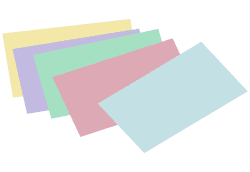Visual artists sometimes talk about using “found objects” in their artwork. In other words, they collect interesting things during the course of a normal day (such as bus tickets, objects from nature, or a toy found on the street) and then find a way to incorporate those objects into their artwork.
Did you know that you can do the same thing with language? A “found poem” is created by collecting interesting text from the world around us and then using those words to make a poem. When you create poetry this way, you are acting like a documentary filmmaker—using scenes from real life to tell an interesting story.
Here are three simple and fun ways to create “found poetry” from the language that is all around you.
Collect Words to Use Later
 First, put an index card in your pocket or backpack to carry with you. All day long, whenever you hear or see a word that is unusual, beautiful, funny, or otherwise interesting to you, write it down on the index card. You could write down what you hear people saying to each other during the day.
First, put an index card in your pocket or backpack to carry with you. All day long, whenever you hear or see a word that is unusual, beautiful, funny, or otherwise interesting to you, write it down on the index card. You could write down what you hear people saying to each other during the day.
Other places to collect words include magazine or book covers, street signs, flyers or banners, or addresses on envelopes. Also, pay attention to the text used for ads and other types of product information, such as TV commercials, billboards, or even the writing on the back of a cereal box.
You can add words or phrases from any of these sources onto your index card. That night, try to use all of the words on your card to write a poem. Remember, you can choose to mix up the order of the words on the card. Add as many new words as you need so that your poem feels finished.
Turning Junk into Poetry
Find a piece of junk mail with a lot of words printed on it. (Be sure to check with your parents about what piece of mail is okay for you to experiment with, since you will be making permanent marks on it.)
Use a bright yellow marker to highlight the most interesting words or phrases that are already printed on the page. Look for words that you like because of how they are spelled, what they mean, or how they sound when you speak them aloud.
Now switch to a dark colored marker, such as black or purple. Fill in all of the spaces between the highlighted words. When you do this, you will even color over the non-highlighted words with the dark marker.
You should now have a solid black or purple page except for a few bright yellow words, which will form a poem. If you use more than one piece of junk mail, you might want to make a very long poem or use each separate page as a different stanza in the poem.
Creating an Altered Poem
Choose an existing poem that you enjoy. It might be a poem that you have written or a famous poem that you like to read. Print out a new copy of the poem from your computer or make a photocopy out of a book.
Now, use scissors to cut up the text of the poem into phrases or even single words. Mix them all up, then create a new poem with them.
If the original poem was a famous one, try to make up a title for the new poem that explains how you were inspired by the old one. For a more advanced challenge, you could find two famous poems that are very different, such as “Nothing Gold Can Stay” by Robert Frost and “The Raven” by Edgar Allen Poe, and use at least half of the words from each poem to create a brand-new hybrid poem.
Your Turn!
Poetry is everywhere you look (and listen), so just keep your eyes and ears open. When you try out these three “found poem” techniques, you will find that experimenting is the best part. There’s no wrong way to make a poem, so have fun!
- Update to Poems-by-Length Page - April 18, 2024
- Create Your Own Poetic Puppet Show - April 16, 2024
- Leap into Laughter with “A Festival for Frogs” - March 26, 2024






